Features of Artificial Stone Kitchen Countertops

Artificial stone countertops are valued for their respectable appearance and high durability. Draws attention to this material and its affordable price. Advantageously distinguishes artificial stone as an arrangement of kitchen work areas and its quality.

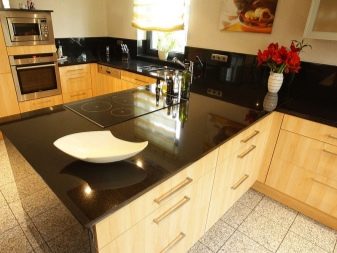
Specifications
Thanks to innovative technologies of modern industry, it has been possible to create a stunning analogue of natural stone. The new development turned out to be more versatile and easier to process, a full-fledged analogy to expensive natural stone, inaccessible to the masses.
Artificial stone is in many ways identical to natural rock, but has improved performance characteristics.
He managed to surpass the original in terms of ease of use and level of hygiene.
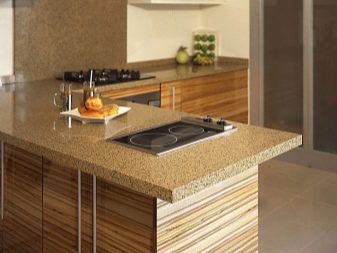
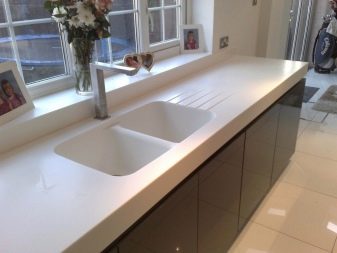
Composition
A composite material is created from specific components:
- aluminum trihydrate (natural mineral);
- acrylic resins - methyl methacrylate (MMA) and polymethyl methacrylate (PMMA);
- fillers of natural origin;
- coloring pigments.
Due to the presence of acrylic resins in the composite, it is often referred to as acrylic.

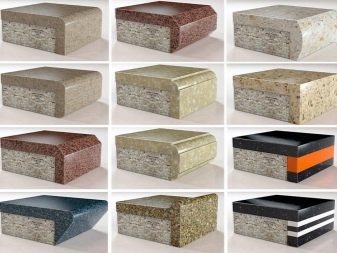
A distinctive feature of good quality composite stone is the relatively high cost of polymethyl methacrylate (PMMA). But it is to him that the finished tabletop, resistant to mechanical damage, owes its strength.
Methyl methacrylate (MMA) is less robust and less expensive. The predominance of any acrylic resin in the composition is not obvious visually, but noticeably affects the operation of the surface and its durability.
Artificial stone is produced according to the conditions of the technological process. Fillers are added in specific proportions, and mixing is carried out in a vacuum environment at an appropriate temperature. The resulting homogeneous mass with a viscous consistency solidifies in special forms, where the composite is finally formed. Sheet thickness is up to 25 mm.
Artificial stone is a generalized name for specific types of composite finishing material with a visual imitation of a natural breed.
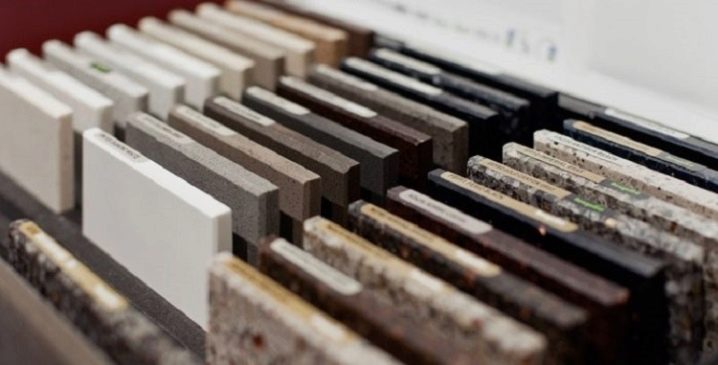
In modern industry, there are several types of such material. These will be discussed below.
Acrylic
It is a mixture of filler and acrylic resin. It is the most popular artificial stone. It is unique, attractive and durable.
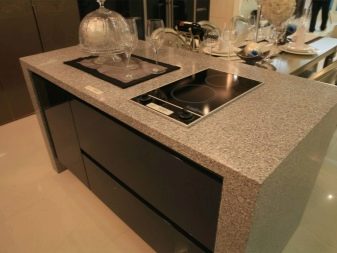
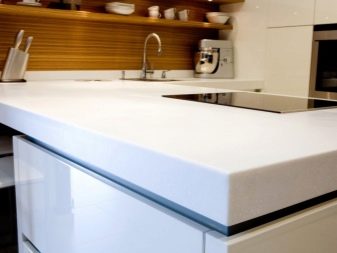
Polyester
Quite a pleasant structure is obtained from polyester resins. Due to the inability to bend like acrylic, it is cheaper and is a high-quality and popular material.

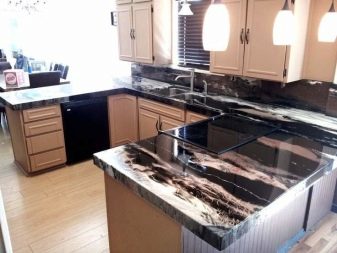
Quartz agglomerate
It is a natural quartz (93%). The remaining 7% of the composition is occupied by sedimentary rocks, coloring pigments and other substances. The material is practical and resistant to acids and other chemicals.
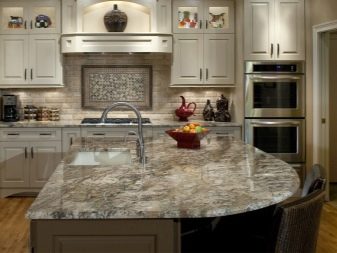
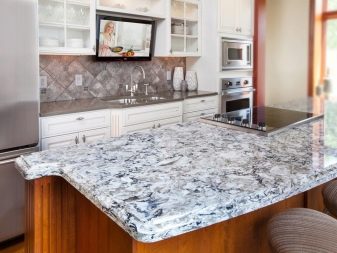
Cast marble
This is a variation on liquid stone. It is also called granite, artificial marble, polymer concrete or cast stone. The disadvantage can be considered a not very pleasant smell emanating from it. In a finished product, it disappears after a few months from the date of operation.
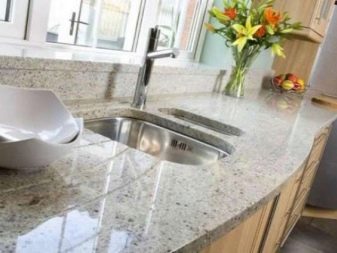
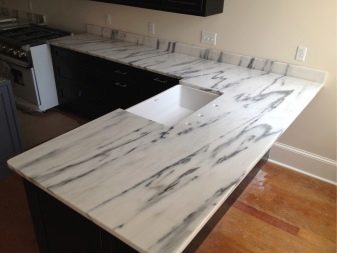
The technologies used during production also affect the characteristics of the composite.It is necessary to take into account the country of the manufacturer and the trade mark, since the origin of the material is reflected in the finished product.
Advantages and disadvantages
Artificial stone is distinguished by certain operational and decorative qualities, ideal for kitchen worktops.
- High strength. The material is resistant to even strong mechanical stress. It transfers loads in the form of strong impacts and allows you to cut food directly on the surface. No blade marks remain on this tabletop. Strong artificial turf is not threatened by scratches, chips and cracks. The tabletop is able to withstand heavy loads, but it is advisable not to test it for strength by chopping meat and abuse it as a cutting board.
- Hygiene. In the artificial stone, in contrast to the natural version, there are no micropores. Due to its anti-hygroscopic properties, there is no chance for germs to spread in such a countertop. This characteristic also has a beneficial effect on the appearance of the work surface. Liquids, even in bright colors, are not absorbed into the surface and do not change its appearance.
This applies to all products that come into contact with the material.
The absence of micropores allows even sinks to be made of artificial stone. They look very stylish and show surface durability in humid environments. A set with a stone countertop and an identical sink is a stylish and practical solution for the kitchen.
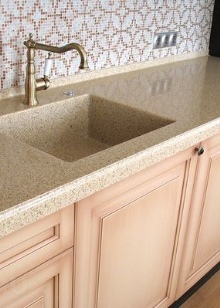

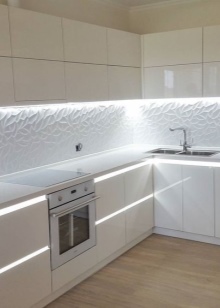
- Maintainability. Damaged composite kitchen worktops can be refurbished with minimal effort. Manufacturers themselves offer such services. Craftsmen from organizations that repair various chips and scratches on the composite can easily bring the countertop back to its original appearance in a short time.
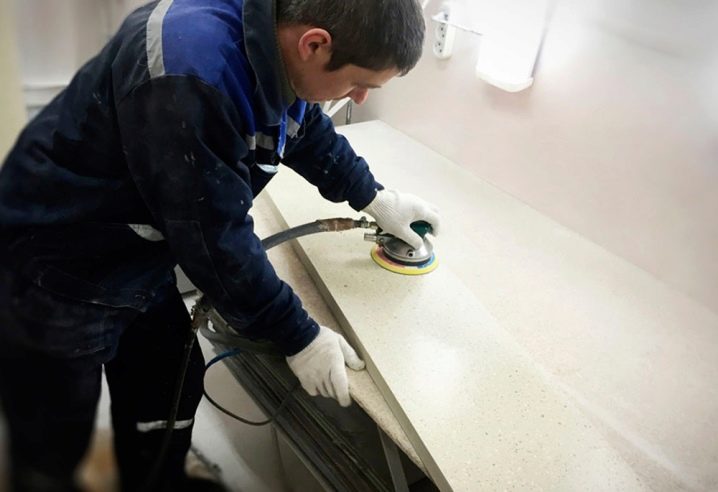
- Plastic. At the stage of production, under the influence of high temperature, the material becomes plastic and it can be given the desired shape. In the process of thermal formation, the embodiment of any design ideas is available.
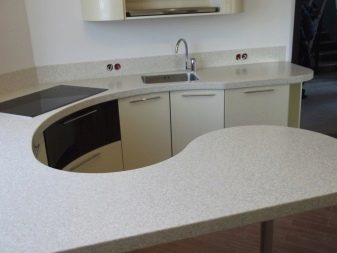
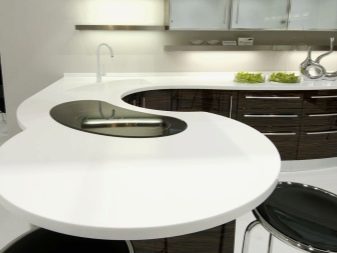
- Seamless connection. Thanks to thermoforming and the individual properties of the artificial material, it is easy to process and produce dimensional worktops without seams. This has a positive effect on the appearance of the work surface, as the number of hard-to-clean places is reduced. But if you still need to connect two parts, then you can use a specialized two-component acrylic-based glue. After high-quality grinding, the joint will be difficult to find.
Visually, such a surface looks completely monolithic.
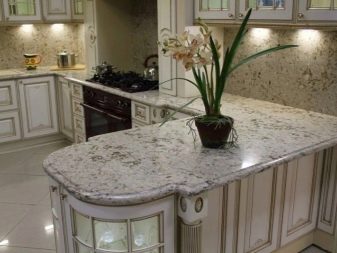
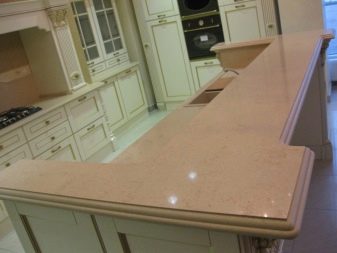
- Reduced thermal conductivity. The surface of the artificial material is warm to the touch, in contrast to the cold natural mineral.
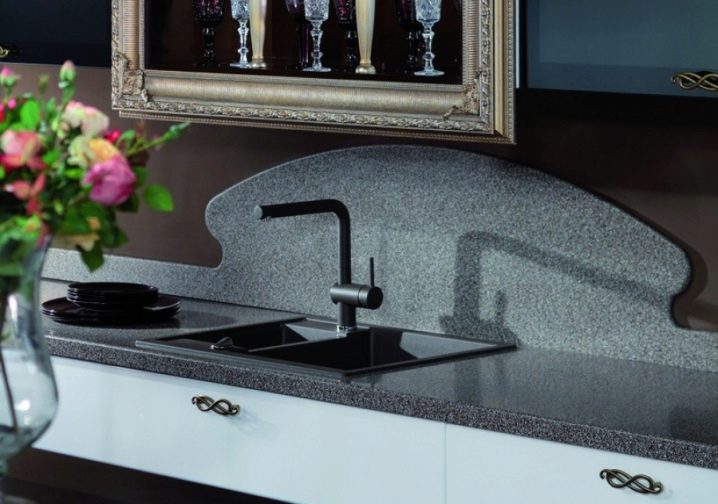
Disadvantages.
- Less durability of an artificially created stone in comparison with a natural analogue.
- Less prestigious status. If the question of prestige and compliance with a certain level is important for the buyer, then he will prefer natural stone in the interior. And those who think about the practical side and ease of care will choose a more environmentally friendly, convenient and affordable replacement option.
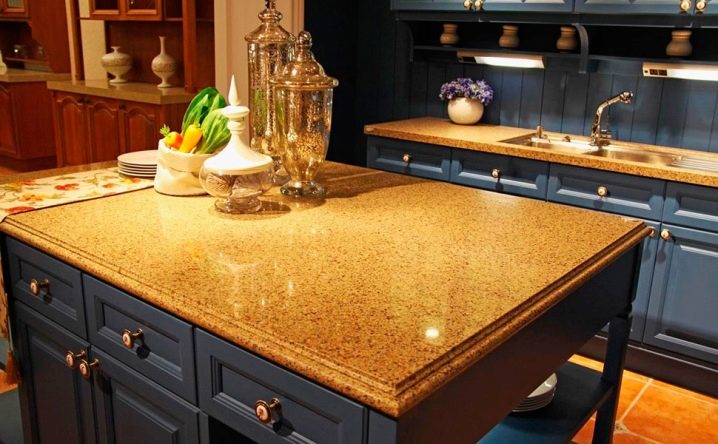
Views
The choice of composite countertops is not limited to size, shape and design. There are several options for composite materials.
Porcelain stoneware
The thickness and dimensions of the products are selected based on the preferences of the customer. This material is purchased for the working kitchen area by those who value strength and durability. Porcelain stoneware has served its owners for decades without any problems.
A thick sheet tabletop is installed based on practicality. It can be used for cutting meat and other operations for preparing food for cooking. The selection of material depends on the cost, which, in turn, depends on the color of the product.
Various shades of artificial countertops are possible, matched as much as possible to marble or a certain interior design.
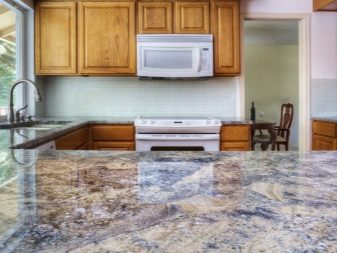
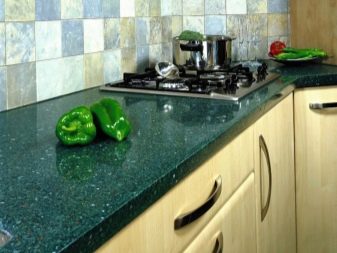
Porcelain stoneware countertops may vary in texture.
They are:
- matte (untreated);
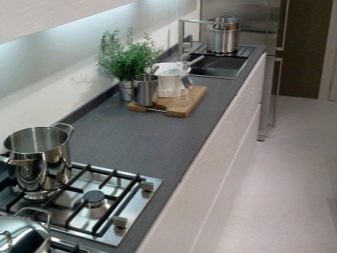
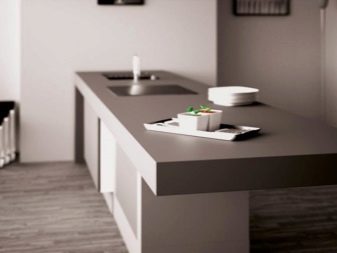
- semi-matte (partially processed);
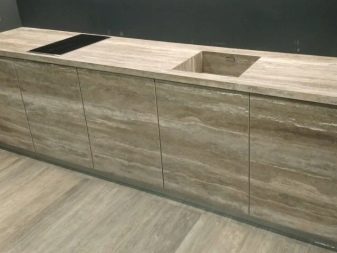
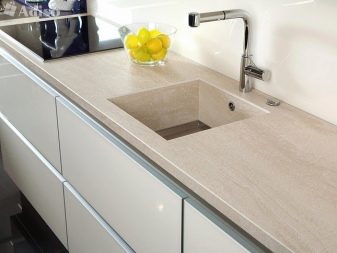
- polished (smooth);

- glazed (anti-slip);
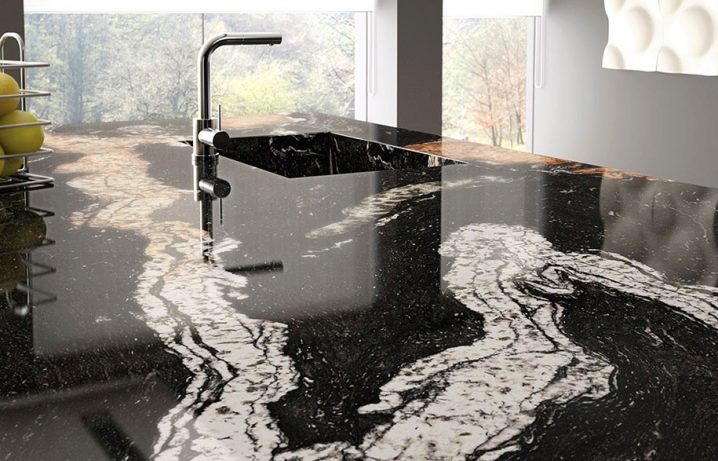
- embossed (with imitation of different materials).

The indisputable advantages of porcelain stoneware can be considered:
- the possibility of laying it on different bases: metal, wood, plastic, concrete;
- the material can be removed from visible defects (chips, scratches and other flaws) in the process of polishing or grinding with a special tool;
- differs in heat resistance;
- moisture resistant and durable;
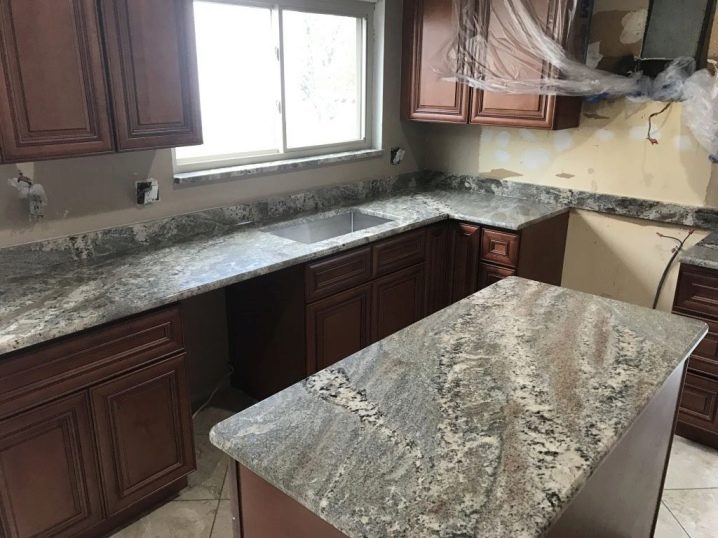
- does not contain harmful additives;
- extra durable - can serve as a cutting board;
- does not emit toxic substances;
- is not a favorable breeding ground for bacteria;
- functional and multicolor.
As for the cost, it is almost 5 times cheaper than natural stone.
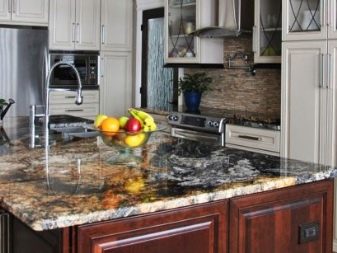
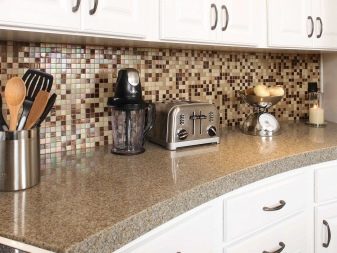
The disadvantages of porcelain stoneware can be described in several points.
- Finishing large-scale surfaces will be costly and time consuming. The joints of the plates will have to be sanded periodically.
- Caring for your countertop requires regular effort. If the surface is not wiped twice a day, porcelain stoneware loses its shine.
- The material is not resistant to acidic cleaning agents. Needs processing with a special polish.
- Installation requires professional assistance.
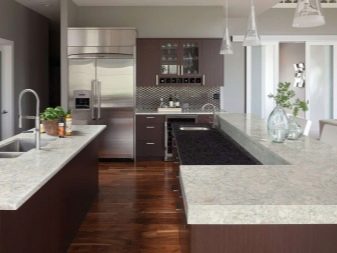

Agglomerate and acrylic stone
These are the most demanded materials for the production of countertops. Both are composite and consist of a certain filler and some binders. The cost is reflected in the thickness, color scheme of the composite, the size of the countertop and the complexity of the manufacturing process.
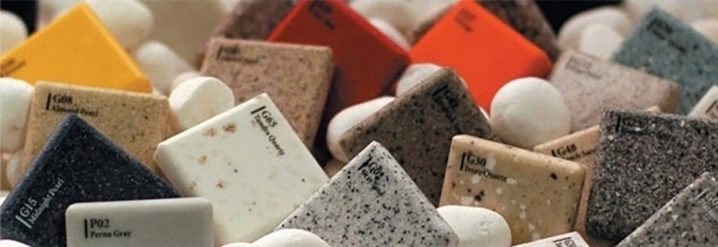
The positive characteristics of the material are described below.
- The range of colors is diverse. Among quartz models, you can choose a base color and match it with inclusions of natural stone.
- The agglomerate is non-toxic and safe - it consists of 90% natural materials.
- Chips and cracks will not appear on products of this type. If a heavy hot frying pan falls onto the countertop, the maximum damage will be a subtle scratch.
- Solid quartz agglomerate countertops are ductile. Installation is allowed both on a complex frame structure and on legs, even with a large-scale countertop area.
- Moisture resistance. Resistance to acids, the formation of mold in the structure, the penetration of fungus and fat into it.
- There is a possibility of inserting a sink or a hob.
- Has no expiration date. It can be operated for more than one generation in a row.

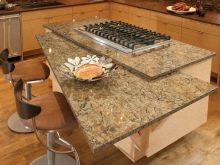
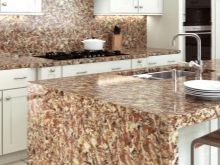
Minuses.
- Seams. The large mass of countertops does not allow them to be manufactured with a large integral area. With a surface size of 1.5 m, two segments are glued together. The joints are filled with a sealant and treated with pigments to match the composite.
- To cut a strong agglomerate, you need special discs and other tools designed for processing marble.
- Difficulty of transportation. The slab is transported strictly vertically.
With a corner structure and edges of 2.5 m, special transport will be required.
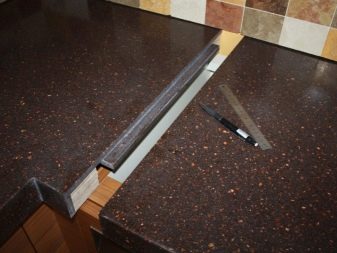

Variety of shapes and colors
Composite countertops allow you to create the most stylish colors. When ordering for the manufacture of a working surface for a headset, you can count on a specific shade and pattern. The richness of pigments provides a tempting wide palette of colors to match the décor of every kitchen.
Thanks to this, it is possible not only to emphasize the style of the room, but also to recreate its unique combination of color shades, which is most suitable for the design requirements. It should be noted that the structure and color of the material are the same due to a special production technology.The appearance of a large-scale countertop remains uniform and identical on the entire surface.
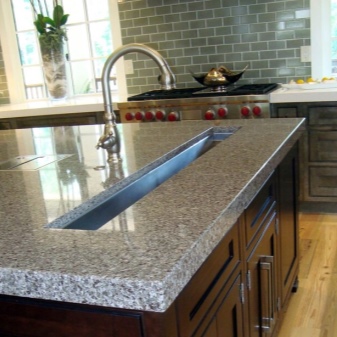
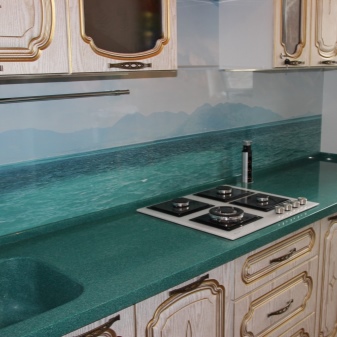
Artificial stone is stylistically versatile, which allows the composite to be used in different directions. It fits well both in the modernist style and in the classic setting, while being ideal in all popular design genres. The embodiment of any form is realized at the production stage. The composite material is bent under heating, cut, and then glued.
As a result, the most popular solutions are obtained.
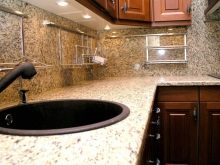
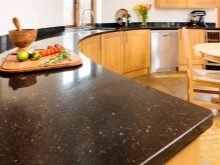

Rectangular
This is a classic shape that fits into the square and dimensions of any kitchen. In length, such a tabletop is no more than 3 m, while a solid plate is used. In the version with an acrylic monolithic tabletop, any length can be, while in the case of quartz there will be seams - due to the large mass of the product, it is not possible to make a solid plate of large dimensions.

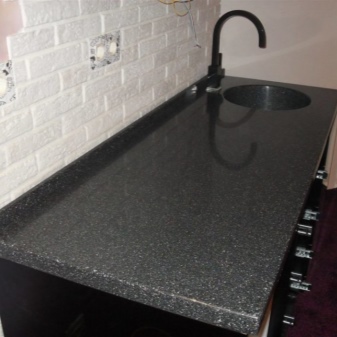
Square
These are more suitable shapes for making dining tables and compact corner tables. Neat dimensions and visual appeal will make such a piece of furniture a "highlight" of the kitchen interior.
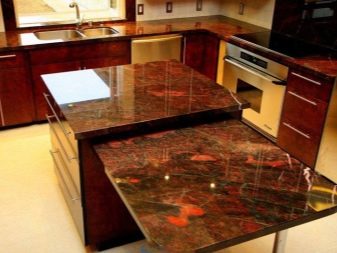
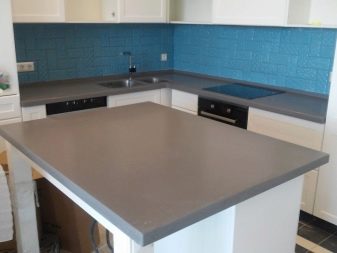
Arcuate
It can be considered that this is the most successful form for stylish bar counters. Such constructions serve for many years and endure the most active and widespread use without prejudice to their appearance.
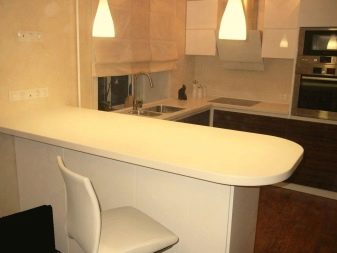
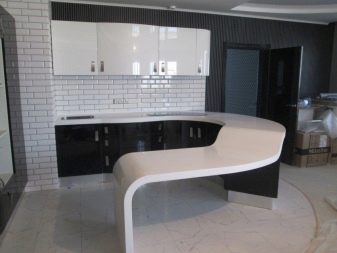
Non-standard
These include semicircular ones, with all kinds of cuts, "waves", with holes of various shapes and configurations. Manufactured according to individual drawings and parameters.
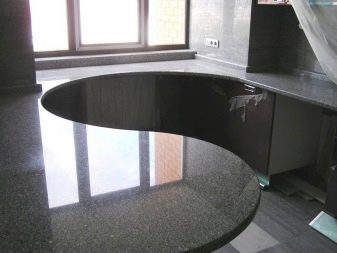

The presence of protective sides is a distinctive element of artificial stone countertops. They are different, but they are always useful according to their principle of the device.
Rectangular
They laconically frame the product and serve as a limiting element that protects against possible overflow of water.
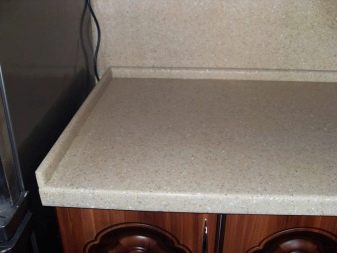
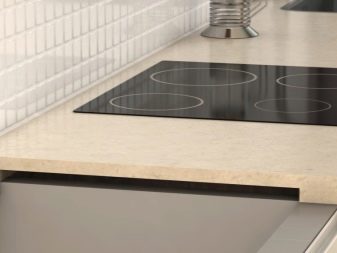
Semi-integrated
They serve to protect the joints between the wall and the work surface of the worktop.
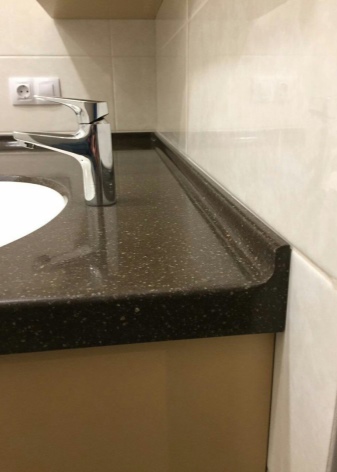
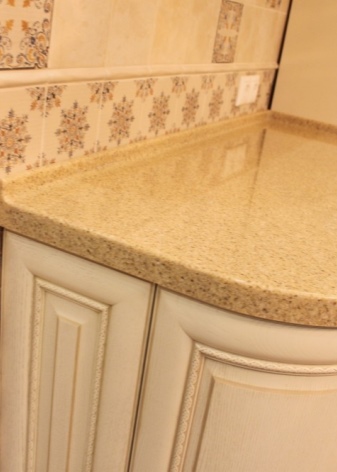
Integrated
In terms of their functions and height, they are similar to rectangular options. Protects seams from water, while equipped with a radial groove for easy cleaning.
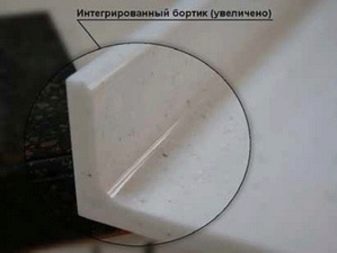

Care Tips
In order for an artificial countertop, identical to a real stone, to retain its aesthetic qualities and durability for a long time, one should not neglect its regular maintenance. To do this, you should perform some manipulations.
- Clean in a circular motion with a mild detergent or liquid soap.
- Do not use abrasives in any form and aggressive chemicals with acids and alkalis.
- A clean, damp countertop should be wiped dry with a towel.
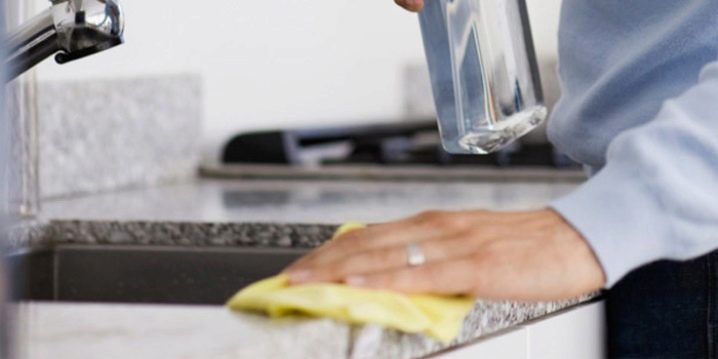
- Wipe off oil, water and food residues after each cooking.
- Do not place hot dishes from the stove on the worktop.
- For extra shine, periodically rub the surface with a special polishing paste.
- Avoid contact with acetone-containing substances, products with methylene chloride on the artificial stone.
- For stubborn grease stains, you can use an ammonia-based formulation.
This substance does not have a destructive effect on the composite, but it copes quite well with fat.
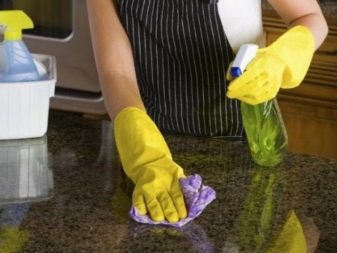
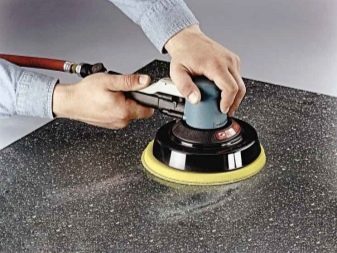
Small surface restoration. For deep scratches, it is best to contact the countertop manufacturer. Experts will come to your home and re-grind and polish the product, giving it its original appearance. Minor scratches caused by a hard sponge or knife can be dealt with without the help of professionally trained repairmen.

Complex repair manipulations include the elimination of chips, the installation of special patches in the place of local damage. It requires the use of special adhesives and a composite material identical in color. The task can be solved by any skillful master. The rest of the manipulations are not so difficult to carry out on your own.
- First of all, you need to sand the damaged area with P120 sandpaper, gradually reducing the grinding to the level of polishing with a P400 grit.
- Then you need to polish the treated area with felt. It is more efficient to do this with a special nozzle on a screwdriver.
- For finishing, a special compound (polyester) is used. It is applied to a previously degreased composite surface. You can buy the product from the sellers of artificial stone. In such specialized points, there is always the necessary arsenal for repair work of varying degrees of complexity.
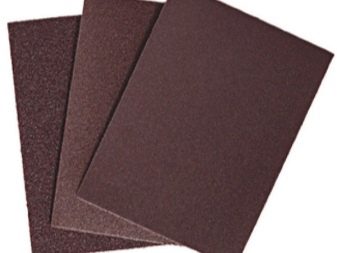
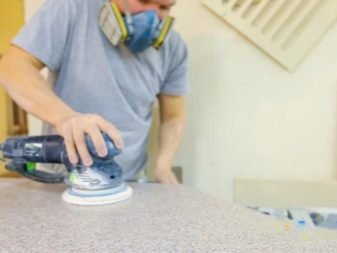
Maintaining the appearance of an artificial stone countertop in its original form is not difficult at all. Due attention and careful handling will allow this piece of furniture to delight the eye for years to come.
For the advantages and disadvantages of artificial stone countertops, see the video below.













The comment was sent successfully.